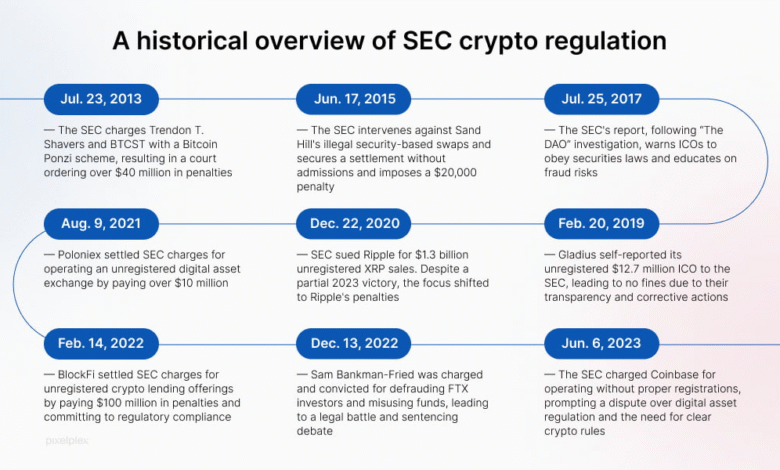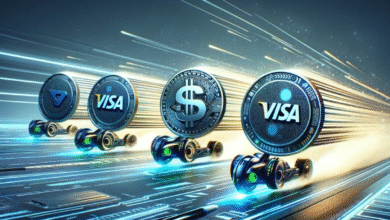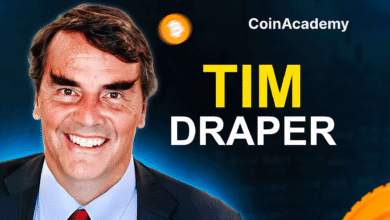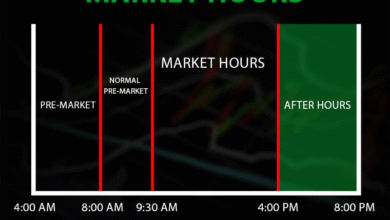SEC Crypto Regulations: Major Policy Shifts Ahead

SEC crypto regulations are on the cusp of a transformative overhaul, designed to propel U.S. digital asset innovation into a new era. With the backing of SEC Chair Paul Atkins, the proposed framework aims to streamline compliance for crypto trading rules, enhancing the clarity surrounding issuance, custody, and trading of crypto assets. Atkins criticizes the previous management of cryptocurrency regulations as stifling growth and pledges to create a more welcoming environment for blockchain technology. His vision seeks to establish sensible guidelines that not only protect investors but also encourage the evolution of cryptocurrency custody and other areas of the sector. As the Commission gears up for these major policy shifts, the discussions surrounding SEC crypto regulations underscore a pivotal moment for both investors and innovators in the digital marketplace.
The upcoming adjustments to the regulatory landscape governing cryptocurrency assets promise to have significant ramifications for all participants in the digital economy. The SEC’s strategy focuses on key aspects of crypto management, which encompass how digital currencies are issued, secured, and exchanged. By rethinking its regulatory approach, especially within the context of digital asset custody and broader trading capabilities, the SEC aims to foster a more robust framework that can keep pace with technological advancements. This initiative comes at a crucial time as industry advocates push for a balanced strategy that safeguards investor interests while stimulating digital asset innovation. As these new measures unfold, stakeholders eagerly anticipate how the framework will reshape the future of cryptocurrency transactions and investment.
The SEC’s Commitment to Transforming Crypto Regulations
The U.S. Securities and Exchange Commission (SEC) is embarking on a pivotal reformation of its cryptocurrency rulebook, focusing on three main areas: issuance, custody, and trading. SEC Chair Paul Atkins has publicly committed to reshaping the existing framework to enable greater digital asset innovation. By addressing regulatory uncertainties, the Commission aims to provide a clearer path for businesses looking to navigate the complexities of crypto asset compliance.
This redevelopment is particularly crucial as the U.S. strives to remain a competitive player in the global digital asset market. A comprehensive crypto asset framework will not only clarify the registration process for token issuances but also reduce the friction associated with compliance, helping to incentivize innovation and secure investments in the burgeoning cryptocurrency sector.
Focus on Crypto Asset Issuance: Creating New Pathways
SEC Chair Paul Atkins identified the need for transparent pathways for businesses issuing crypto assets. A significant proportion of potential crypto innovation has been stifled due to the ambiguity surrounding securities laws and the implications of regulatory compliance. By providing more pointed guidance and considering exemptions, the SEC could create an environment where emerging companies are encouraged to pursue registered offerings without fear of retribution from the regulatory body.
This initiative cultivates a more favorable landscape for investment in digital assets, allowing companies to leverage compliant avenues that have been historically underutilized. Such efforts will not only enhance investor confidence but also stimulate growth in the digital economy, establishing a robust foundation for the future of cryptocurrency offerings.
Redefining Cryptocurrency Custody Practices
One of the critical areas highlighted by Atkins is the improvement of custody services for crypto assets. Existing regulations have posed barriers to companies wishing to provide custodial services for both security and non-security crypto assets. By advocating for enhanced flexibility and clarity around custody provisions, the SEC is paving the way for innovation in how these digital assets are secured, further legitimizing custodial solutions in the eyes of investors.
Moreover, the removal of outdated regulations, such as Staff Accounting Bulletin No. 121, demonstrates the SEC’s commitment to modernizing custodial frameworks to reflect the realities of digital transactions. This strategic shift could empower custodians to utilize advanced security measures, including self-custody options, thereby increasing the overall security and accessibility of crypto assets.
Trading Flexibility: Adapting to Market Needs
The SEC is also taking steps to enhance the regulatory landscape around crypto trading. Chair Paul Atkins emphasized the need for broader flexibility in trading rules, enabling platforms to cater to the products and services currently demanded by the market. By revisiting alternative trading systems and offering more customized solutions, the SEC can encourage the liquidity and diversity of crypto products available to investors.
This adaptive approach resonates well with the fast-paced nature of the cryptocurrency market, which often outpaces regulatory slowdowns. The Commission’s willingness to adjust its policies could foster an environment where crypto exchanges can innovate and grow without undue restrictions, ultimately benefiting consumers and promoting a vibrant marketplace.
SEC Crypto Regulations: A Policy Shift for Innovation
The anticipated changes to SEC crypto regulations are poised to have a lasting impact on the U.S. digital economy. As outlined by SEC Chair Paul Atkins, the emphasis on innovation, clarity, and rationalized legislative measures is indicative of a broader trend toward supporting cryptocurrency growth. This policy shift aims to optimize the regulatory environment for crypto trading rules and accommodate the rapid evolution of digital assets.
With the SEC committed to establishing a more transparent framework, companies will find clearer guidelines for compliance, which is essential for ensuring thorough investor protections while simultaneously promoting economic growth in this sector. The intention is to strike a balance between effective oversight and allowing the market to thrive, supporting the innovation needed for the U.S. to maintain its competitive edge in the global crypto arena.
Investor Protection vs. Crypto Innovation: A Balancing Act
While the SEC’s proposed reforms aim to boost innovation within the crypto landscape, they have also sparked discussions around investor protections. The skepticism surrounding potential lapses in safe practices highlights the delicate balance regulators must strike. It is crucial that while fostering a conducive environment for digital asset development, the SEC remains vigilant in safeguarding the interests of investors, ensuring they are not left vulnerable in the wake of rapid industry changes.
Investor confidence is a cornerstone for the success of any regulatory framework. As the SEC moves to redefine its approach, maintaining rigorous standards for transparency and accountability will be paramount. By instituting robust protocols alongside innovative guidelines, the SEC can cultivate trust in the cryptocurrency market while supporting its growth, underscoring its commitment to both innovation and protection.
Anticipating Future Developments in Crypto Regulations
As the SEC prepares to roll out its revised framework for crypto assets, industry stakeholders are closely monitoring the developments. The anticipated regulatory changes will mark a significant shift toward a more structured approach to digital asset management, which is vital for the maturation of the cryptocurrency ecosystem. Stakeholders in the crypto community are hopeful that these reforms will create an environment conducive to responsible innovation.
Going forward, continuous dialogue between regulators, industry leaders, and investors will be essential to ensure that regulations remain relevant and pragmatic. The SEC’s readiness to explore conditional regulations and bespoke solutions for digital assets will be instrumental in laying the groundwork for a dynamic and competitive crypto market.
The Role of Regulatory Guidance in Crypto Custody Solutions
Amidst the evolving crypto landscape, regulatory guidance related to cryptocurrency custody remains a priority for the SEC. The need for a solid framework that outlines how custodians manage digital assets is becoming increasingly evident as more institutions look to enter this space. Ensuring custodial practices are transparent and secure is fundamental for protecting investor assets and maintaining market integrity.
Effective custody solutions are essential for facilitating institutional investment in cryptocurrency. By clarifying expectations and minimizing regulatory burdens, the SEC can encourage firms to develop innovative custody services that align with the unique requirements of the crypto asset ecosystem. Improved regulatory clarity can ultimately lead to enhanced trust and facilitate greater participation in the market.
Conclusion: Navigating the Future of Crypto Regulation
As the SEC moves forward with its reformation of crypto regulations, the future landscape of digital assets in the U.S. appears promising. With an emphasis on innovation while maintaining investor safeguards, the SEC aims to create a regulatory environment that accommodates the unique nature of cryptocurrencies and blockchain technology. Stakeholders in this sector will have to remain engaged with the ongoing developments to capitalize on the opportunities that these changes may bring.
The journey toward a more robust and balanced regulatory framework is crucial not just for the survival of crypto assets but also for America’s standing as a leader in digital innovation. By aligning regulations with the realities and potentials of the digital currency market, the SEC can pave the way for a new era of growth and transformation in the financial landscape.
Frequently Asked Questions
What are the main areas of focus in the SEC’s crypto regulations?
The SEC’s crypto regulations primarily focus on three key areas: issuance, custody, and trading of digital assets. SEC Chair Paul Atkins has emphasized the need for clear guidelines in these areas to enhance U.S. digital asset innovation.
How does the SEC’s crypto asset framework address issuance challenges?
The SEC’s crypto asset framework aims to provide issuers with guidance and possible exemptions to foster compliant pathways for crypto asset issuance. Chair Paul Atkins has suggested removing regulatory uncertainties that currently hinder registered offerings and Regulation A.
What changes are expected in cryptocurrency custody regulations?
The SEC is evaluating its approach to cryptocurrency custody, advocating for greater flexibility for registrants. Recent actions have aimed to clarify how custody rules apply to both security and non-security crypto assets, potentially introducing new custodial methods.
How will the SEC’s crypto trading rules impact the market?
The SEC’s upcoming crypto trading rules are expected to allow broader trading options for registrants, aligning with market demands. Chair Paul Atkins is pushing for modifications to alternative trading system regulations to support this flexibility.
Are there any implications for digital asset innovation under the SEC’s new guidelines?
Yes, the SEC’s new guidelines are designed to bolster digital asset innovation by creating a supportive regulatory environment. Chair Paul Atkins emphasizes that businesses should not feel the need to relocate operations offshore due to restrictive regulations.
What is the significance of SEC Chair Paul Atkins’ reform agenda for crypto regulations?
SEC Chair Paul Atkins’ reform agenda signifies a major policy shift towards sensible and innovation-friendly regulations for crypto assets. His focus on clear guidelines for issuance, custody, and trading seeks to enhance compliance while fostering growth in the U.S. crypto market.
How is the SEC planning to protect investors while revising crypto regulations?
While the SEC is planning to ease regulations to support innovation, Chair Paul Atkins acknowledges the importance of investor protection. The new regulatory framework will strive to balance fostering growth and safeguarding investor interests within the evolving crypto landscape.
What role does self-custody play in the SEC’s approach to digital assets?
The SEC is considering new rules that would recognize self-custody of crypto assets as a legitimate method, enhancing flexibility for registrants while ensuring that customer protection measures are upheld.
How can registrants benefit from the SEC’s updated cryptocurrency custody regulations?
Registrants can benefit from the SEC’s updated cryptocurrency custody regulations through increased flexibility in how they manage and safeguard crypto assets, potentially simplifying compliance and promoting innovation in custody solutions.
What are the potential risks associated with the SEC’s changes to crypto trading regulations?
As the SEC revises crypto trading regulations, there could be risks related to the adequacy of investor protection and market oversight. Critics express concerns that relaxing rules may lead to vulnerabilities in safeguarding investors.
| Key Focus Areas | Key Points |
|---|---|
| Issuance | The SEC aims to provide clear guidelines for the distribution of crypto assets that qualify as securities or investment contracts. |
| Custody | Proposing greater flexibility in how registrants handle crypto assets, including the possibility of self-custody. |
| Trading | Support for broader trading options by registrants in response to market demand, with potential customization of rules for crypto assets. |
| Innovation | Concerned about loss of innovation to foreign markets, the SEC considers developing a comprehensive regulatory framework to encourage U.S. innovation. |
Summary
SEC crypto regulations are on the verge of a significant transformation as the SEC Chair Paul Atkins outlines a comprehensive plan to enhance the regulatory environment for digital assets. The focus on issuance, custody, and trading aims to facilitate innovation while ensuring investor protection. This shift is crucial for maintaining U.S. competitiveness in the rapidly evolving digital asset market, preventing innovation from shifting overseas. As the SEC moves forward, this more rational and innovation-friendly framework is expected to provide clearer paths for businesses and bolster the growth of the crypto sector.




